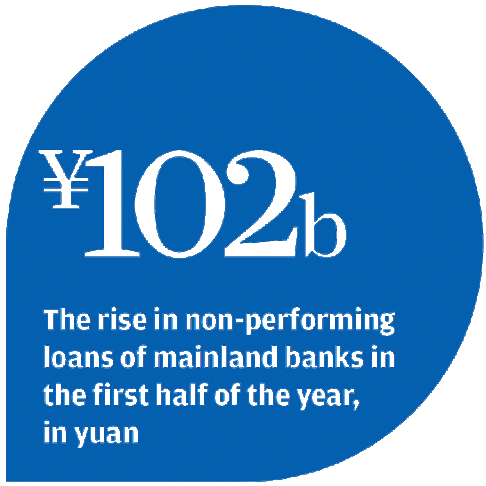
China bank sector unfazed by sharp jump in bad debts
Market appears calm over the rapid rise that has been expected and seen as sign of greater transparency even though more defaults are looming
The mainland banking sector is eerily calm for logging a 102.3 billion yuan (HK$129 billion) increase in non-performing loans in the first half of the year. And there is more where that came from in the second half, as defaults in sectors such as steel and property are expected to increase in coastal provinces.

The market has remained composed mainly because the rapid increase was expected, even welcomed as a sign of greater transparency in the dark accounting offices at the China Banking Regulatory Commission in Beijing.
"We continue to believe better NPL recognition will help improve credit allocation in China," Morgan Stanley's Richard Xu said in a research note last week.
Among the five biggest banks, the non-performing loan ratio in the first half averaged 1.08 per cent, according to figures compiled by the . The CBRC put the industry average in the second quarter at the same rate.
Not all major state banks had the same appetite for risk, interim earnings results released in the past two weeks showed.
Agricultural Bank of China posted the highest bad-loan ratio of 1.24 per cent, yet the slowest rate of growth in that ratio since the end of last year: just 2 basis points. At 0.99 per cent, Industrial and Commercial Bank of China - the world's largest bank by assets and market capitalisation- had the lowest ratio. Bank of Communications' ratio rose 8 basis points, the most rapid growth among the five biggest banks.
The most worrisome bad-loan formation in the first half happened at joint-stock banks and rural commercial lenders. China Merchants Bank saw bad loans jump to 0.98 per cent from 0.71 per cent at the end of June last year. The ratio is still low but the increase of 27 basis points in a year was higher than the industry average and troubling if unaddressed in the second half.
China Citic Bank Corp's non-performing loan ratio jumped 16 basis points to 1.19 per cent, well above the sector average. Data from the CBRC showed the average ratio at joint-stock banks has climbed to just below 1 per cent from a safe 0.6 per cent at the start of 2012.
Still, analysts are unalarmed and generally positive on the sector. To investors, the mainland's biggest banks have been a bore this year. The average share price of the five biggest banks tumbled more than 15 per cent in mid-March on poor economic data only to rally in June and July as economic activity warmed again.
The outlook for the mainland economy is less clear. The five banks are trading at an average price that is about the same as at the start of the year while the Hang Seng Index has climbed 6.4 per cent and the H-share index is up 1.8 per cent.
The nature of bad loans at the banks has kept many analysts cool headed on the topic. The banks have a long history of successfully removing non-performing loans from their balance sheets by selling them off to centrally established asset management companies.
Nearly a decade ago, the biggest banks sold massive amounts of bad debt to the toxic-asset managers before they went public overseas. Richard Cao, a Shenzhen-based banking analyst at Guotai Junan International, likened that period to today in respect to the volume of bad-loan disposals banks are conducting.
"The People's Bank of China has issued some directions to the banks to boost the disposal of bad loans," Cao said. "So we don't see the NPL ratio growing so quickly … We don't think it will go beyond our expectations in the second half."
